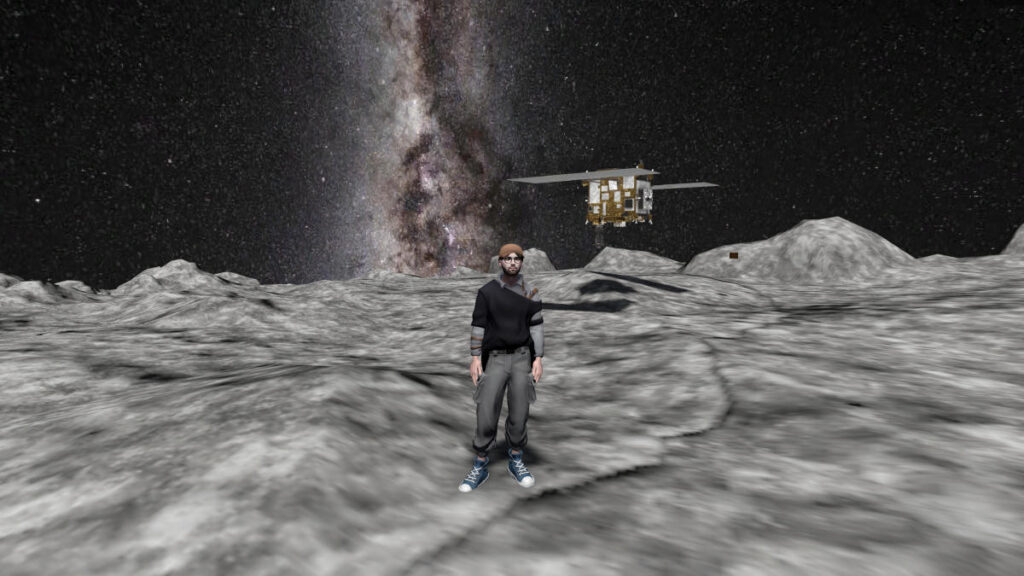I’m standing so close to JAXA’s Hayabusa2 asteroid lander that I could touch it. Instead, I jump on top of it. Then I strike a pose. When I jump off, I float briefly in the low gravity before landing gently on the surface of Ryugu, a rocky, gray world devoid of life and color.
The “I” in this situation is my avatar, a digital approximation of myself who has a more consistent beard length and isn’t constantly rubbing sleep from his eyes. The Hayabusa2 spacecraft I was standing on, and the asteroid below are also digital avatars, recreated in virtual reality.
The VR experience I was in is part of the Astronomical Society of Australia’s 2024 annual scientific meeting, where the country’s astronomers will come together to present new research, share results and mingle. This year’s meeting, in June, was almost entirely online, using the platform Spatial to allow participants to access the conference in VR.
A digital location, with poster halls, exhibition halls, meeting rooms and a lecture hall, was built by The Future of Meetingsan international collaboration that aims to make meetings more sustainable and accessible.
Related: Asteroid Ryugu holds secrets about the past, present and future of our solar system
I was initially a little apprehensive about attending the conference in VR. I’m a VR skeptic, having worked as a video game journalist and seen the up-and-down (mostly down) hype surrounding this technology. But as a space tragicomedy and someone who has stood on top of a sand hill in Coober Pedy, Australia, as monsters of Ryugu came storming back to Soil in 2020 i would also describe myself as bloody excited to be standing on an asteroid.
So during the conference I booted up Spatial, walked my avatar through the exhibit hall, and pushed it through a portal to Ryugu and the spaceship it visited in 2018. It felt a bit like I was playing Super Mario 64 and jumped through a portrait.
I immediately dropped down onto the surface of the asteroid. The Ryugu model was made by OmniScopea startup founded by astronomer Sasha Kaurov to create virtual worlds for science education, using real images captured by Hayabusa2It’s not a perfect replica, but it’s certainly a re-creation of the area around the spacecraft’s landing zone: the shadowy plain that JAXA with a place to touchdown and grab equipment in 2019.
Elizabeth Tasker, professor at JAXA and part of the agency’s outreach team, noted that it is difficult to determine whether Ryugu’s topology is to scale. However, she said, models of Hayabusa2, as well as the lander and rovers, are to scale.
There isn’t much to do in Ryugu World other than marvel at space, but that’s kind of the point. This isn’t a video game. It’s a tool. Especially in room and planetary science, the appeal is clear: using real-world data and observations, we can visit places we could never physically reach.
Tasker toured the Spatial exhibit during the ASA meeting, pointing out specific aspects of the Hayabusa2 spacecraft — features that wouldn’t be so easy to spot if presented in a PowerPoint slide. The 3D digital model provides a way to get a closer look at the spacecraft and examine finer details, such as where the target markers and small carry-on impactor were stored during operations.
However, the Ryugu surface is not a complete asteroid. You cannot walk from one side to the other.
“I did mention at the end of the tour that it was possible (and quite easy in the low gravity environment) to run off the end of the asteroid scene and fall into space,” Tasker said. “This was supposed to be a warning, but promptly resulted in at least one person heading to their (virtual) doom! Fortunately, after a brief fall timeyou are reborn on the surface of the asteroid.”
Related Stories:
—What would happen if the asteroid Ryugu hit Earth?
— If an asteroid really did threaten Earth, what would a planetary defense mission look like?
When you stand on the VR surface of an asteroid, something happens in your brain that makes the experience sticky. I’ve written more words about Ryugu’s surface, its chemistry, and its importance to planetary science than most, but standing on it, even digitally, provided a genuine “oh, damn it” moment — a realization of the difficulty of landing on a tiny boulder floating millions of miles from Earth.
When I was done, of course, I jumped over the edge.

